Selected illustrations from Birk’s Comedy — Inferno
(All images can be located in the Chronicle Books editions.)
Inferno 5: Paolo and Francesca (Sandow Birk: Inf. 5.58-59) and (Gustave Doré: Inf. 5.32-33)
Birk’s portrayal of Paolo and Francesca in Inferno 5 displays many of the original and thought-provoking aspects of the artist’s illustration of The Divine Comedy, which itself can be considered an adaptation of Gustave Doré’s engravings (published between 1861 and 1868 by Hachette Books). Here, the California-born artist appears to slightly shift the center of Doré’s composition in order to emphasize the human figures in the middle of the newly-envisioned “American” landscape. In Doré’s romanticized engraving, the pilgrim and his guide are dwarfed by the landscape. Birk’s Vergil, who is more prominent in this composition, wears an American flag and is poised with Dante on a broken overlook of concrete, with a helicopter, symbol of state surveillance, in the distance. Like the rest of Birk’s illustrations, this creative adaptation inspires us to contextualize Dante’s ethics in modern-day American realities. Is Birk trying to say that modern-day love and passion are at odds with a state-controlled existence, for instance?
Inferno 6: The Gluttonous (Sandow Birk: Inf. 6.53-55) and (Gustave Doré: Inf. 6.49-52)
Birk’s illustrations of the Inferno often target American consumerist culture. This critique first appears (unsurprisingly) in his depiction of the gluttonous in Inferno 6, where the signage of global food merchandising is as abundant as the bloated bodies underneath, which are noticeably plumper than the Michelangelesque nudes in Doré’s work. Other types of cuisine appear on the marquees, such as tacos, Vietnamese food, and so forth. Quantity is emphasized: the signs read, “Eat Here or Take Out,” “Smorgasbord,” and “All You Can Eat.” Empty pizza boxes and food containers from KFC and 7 Eleven (Big Gulp) are strewn amongst the souls. Some of these brands appear again in his depiction of the City of Dis (Inferno 8), which features “Starbucks Coffee,” “Chinese Fast Food,” “Donuts,” “Check Cashing,” and a “76” gas stand. Signs for a “Food Mart” and a “KFC” appear once more in Inferno 27.
The Doré engraving features the Florentine sinner, Ciacco, pointing toward the pilgrim in a gesture that conveys the ominous tone of the prophecy of Dante’s exile. Here, Ciacco offers the pilgrim a sip from his oversized beverage, which elicits the pilgrim’s hesitant stance. Vergil dons his American flag as a toga (as well as sunglasses), like he does in the illustration for Inferno 5. He will swap his American flag for the California state one in the successive canto, Inferno 7, only to revert to an American flag again in the illustration to Inferno 8.
Inferno 11: Pope Anastasius (Sandow Birk: Inf. 11.9-11) and (Gustave Doré: Inf. 11.6-7)
The odor of Anastasius’s tomb might visibly “stink” in Doré, as smoke rises from the infernal depth, but in Birk’s composition of Inferno 11, which features the same spirals of foul-smelling clouds, the tomb becomes a broken refrigerator with “Pope Anastasius” tagged onto its visible side. In Doré’s engraving, the pilgrim and his guide share the same posture but both appear different in Birk’s image. Here, Dante is holding a canned drink, perhaps taken from the refrigerator (the ice cube trays have fallen out as well). Birk’s Vergil wears yet another kind of toga, this one a billboard for waxing, facials and pedicures, for which perhaps he has traded his American flag. Can national pride be relegated as secondary to material desire? Or is this simply a tongue-in-cheek reference to hygienic practices in light of the infernal filth of this area? Hence the signs behind the two figures for detergents, soaps and cleaning products, as well as the “No Parking” sign for “Street Cleaning,” all of which appear under the larger words, “SWAP MEET.” When a pope’s tomb becomes a discarded refrigerator, together with a broken television set, we see how Birk scales down references to institutional religions, a motif that will carry through to his illustrations of the Celestial Rose in Paradiso (which Birk figures as Kaaba).
Inferno 15: Brunetto Latini (Sandow Birk: Inf. 15.17-19) and (Gustave Doré: Inf. 15.30)
The sinner’s posture in Birk’s illustration is a direct transposition of Dorè’s corpulent figuration of Latini, who here appears in a construction site where pipes are being laid. He is alone and surrounded by traffic signs, with a highway overpass and construction machinery in the background. Lower hell is marked in Birk’s illustrations by references to the world of urban planning, evoking current problems with American infrastructure but also offering a sarcastic take on such nuisances as traffic congestion, as seen in the Inferno 34 illustration of Lucifer, who is stuck in the middle of a highway exchange. Woes with the highways and byways of America and a reference to road rage may also be read into Birk’s drawings of the sinners who reside in the Circle of the Violent.
In an interesting parallel, for Dante, the expansion of Florence due to a population influx from the surrounding contado contributed to its downfall from a golden period of history (during which his ancestor Cacciaguida, from the Sphere of Mars, resided in their native city). From yet another perspective, one might see the appearance of Brunetto Latini, who emerges from a man-made hole in a construction site, as reflective of both the “worldly-ness” of Dante’s poem and Birk’s interpretation of that afterlife: the inhabitants of Birk’s afterlife reside just under the surface of the street.
Vergil’s toga, which adapts like a chameleon to its surroundings in Birk’s illustrations, here reads, “OPEN DURING CONSTRUCTION.” In other words, the voyage through the afterlife continues, even if the infernal topography – like our own urban landscape – is undergoing development. And, just as adaptations of Dante’s afterlife have continued throughout the centuries, so will the afterlife of this poem always be “under construction.”
Inferno 17: Geryon (Sandow Birk: Inf. 17.6-9) and (Gustave Doré: Inf. 17.7-8)
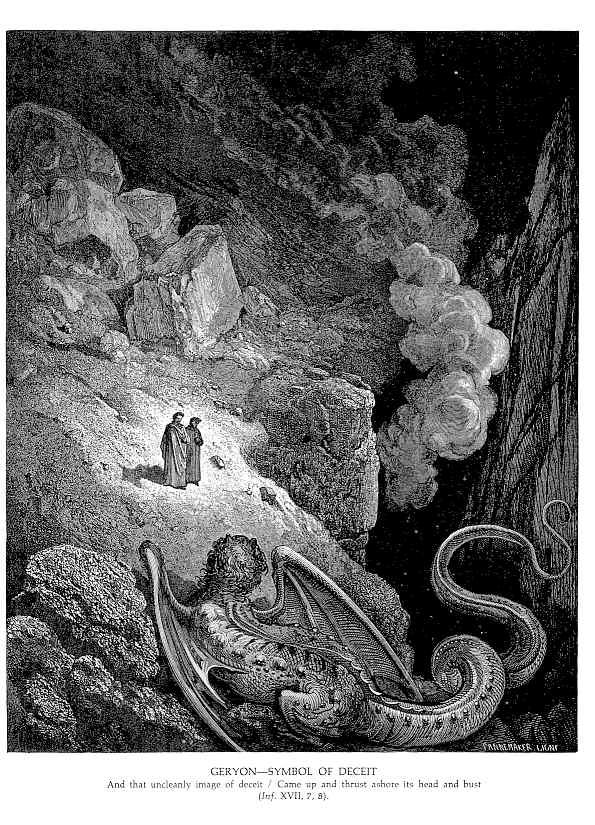 The Circle of the Violent, where Birk’s souls are the protagonists in traffic congestion, speaks to the impossibility of a harmonious relationship with nature. In another critique of the American lifestyle, means of transportation here are heavily based on individual options which are known to be noxious to the environment. Geryon, who makes possible the physical transition from the seventh to the eighth circle, is a helicopter (“Geryon Transport”) in one image (Inferno 16), but an SUV with a tail in yet another (Inferno 17). In Inferno 17, Geryon can be seen in the foreground while a large Taco Bell stands in the center of the composition, replacing the rocky cliff in Doré’s engraving. Again, Birk’s illustration closely mirrors Doré’s in its composition, with noteworthy departures from the French illustrator’s original work: whereas in Doré, Geryon cranes his head to face Dante and Vergil, in Birk, Geryon is reduced to an SUV parked next to the smiling face of “Big Boy,” the new, dirty image of a “just man.”
The Circle of the Violent, where Birk’s souls are the protagonists in traffic congestion, speaks to the impossibility of a harmonious relationship with nature. In another critique of the American lifestyle, means of transportation here are heavily based on individual options which are known to be noxious to the environment. Geryon, who makes possible the physical transition from the seventh to the eighth circle, is a helicopter (“Geryon Transport”) in one image (Inferno 16), but an SUV with a tail in yet another (Inferno 17). In Inferno 17, Geryon can be seen in the foreground while a large Taco Bell stands in the center of the composition, replacing the rocky cliff in Doré’s engraving. Again, Birk’s illustration closely mirrors Doré’s in its composition, with noteworthy departures from the French illustrator’s original work: whereas in Doré, Geryon cranes his head to face Dante and Vergil, in Birk, Geryon is reduced to an SUV parked next to the smiling face of “Big Boy,” the new, dirty image of a “just man.”
Inferno 19: the Simonists (Sandow Birk: Inf. 19.20-24) and (Gustave Doré: Inf. 19.49-50)
In Birk’s illustration to Inf. 19, we see many of the same themes that were referenced earlier, namely those of urban infrastructure and transportation. Here, the simonists – figures of church corruption in Dante’s original poem, and of pollution (with steam rising from their potholes) in Birk’s illustration – are located within a parking lot for the “Malebolge Convention Center,” where the Devils, a basketball team, play. In the Inferno, the burning, oily soles of the simonists’ feet protrude from circular stone openings in the ground. All of this imagery is intended to evoke ecclesiastical offices like baptism—the holes are meant to recall baptismal fonts (like the one which the poet describes breaking in a superhuman feat at the beginning of canto 19), and the perverted presence of the Holy Spirit, traditionally represented by tongues of fire. Birk brilliantly employs potholes for the simonists, since they naturally emit smoke.
The presence of a few palm trees in the background could signify that we are in Los Angeles, but, as the artist has once stated, his scenes from the Inferno do not necessarily all take place in LA. The reference to the Devils could be a playful reference to the Angels baseball team (the Los Angeles Angels of Anaheim), or to the New Jersey Devils, given that Vergil’s toga reads: “I <3 New York.”
Inferno 21: the Malebranche (Sandow Birk: Inf. 21.66-68) and (Gustave Doré: Inf. 21.72)
Birk’s illustrations take on a new subject matter in Inferno 21, when Vergil and the pilgrim encounter the Malebranche, demons in hell who preside over the barrators, souls immersed in black pitch (Circle 8, pouch five). The ranks of the devils are composed of the homeless, wielding signs reading “Will Work for Food,” “Homeless Veteran Will Work,” and “Spare Change: God Bless.” The homeless, the souls who dwell without shelter in this postmodern landscape, become another force of bewilderment and confusion for the pilgrim as Birk conflates them with the forces of the state in this illustration. Here, the homeless are a militia, but without state-sanctioned power. In the accompanying verse translation which serves as a caption to this image, Birk and Sanders describe the halted manner in which the Malebranche confront the pilgrim as an aggressive crowd that needs to be controlled: “When they saw him coming toward them, / the monsters charged at him with their spears, / but at the last moment, they pulled up short like / a charging crowd that comes across a tear-gas canister” (65-68). The demons who are tasked with overseeing the barrators in Dante’s poem are meant to maintain an infernal order; in Birk, these demons are disenfranchised souls who ironically police the streets as surrogates for a state-sanctioned militia, but who must also be checked themselves.
Inferno 23: the Hypocrites (Sandow Birk: Inf. 23.59-61) and (Gustave Doré: Inf. 23.91-93)
This illustration features the LAPD and other members of the working class – with the noticeable addition of one priest – marching rank and file toward business skyscrapers, figured as the hypocrites of Inferno 23. Among the skyscrapers stands LA’s massive Cathedral of Our Lady of the Angels, a grandiose building that was criticized for diverting money from the needy poor for its costly construction. We see in this canto, once again, the creativity of Birk’s illustrations in adapting Dante’s spirit of social commentary: where Dante once targeted members of the church (clergy populate this pouch in the original poem), Birk explicitly aims his satire at those who work for the state (see also the caption for Inferno 21). Considering the questionable behavior of the LA police during the city’s 1992 riots, is Birk asserting that the state symbolizes the absence of ethical behavior in today’s urban environment? If Dante saw hypocrisy within the forces of the church that aimed for control of the state, then Birk, perhaps, is not far from Dante’s spirit in identifying the abuse of power exerted by the state itself in a city (like Dante’s Florence) torn apart by civil strife.
Inferno 31: the Giants (Sandow Birk: Inf. 31.130-132)
In a moment that appears to evoke humor more than satire, Birk substitutes an inflatable Fred Flintstone for one of the giants who surround the frozen lake, Cocytus. Yet there is much more that can be read in Birk’s departure from the original poem. As he transposes Dante’s otherworld onto the locations of this world, Birk turns the ground floor of a convention center or box store (which is in the moment of its “Grand Opening,” as the banner to the right conveys), into the very bottom of Hell. Just as the amusements of our material culture, which here also evoke the world of entertainment, do not provide us with spiritual satisfaction, so is the Fred Flintstone incapable of moving or helping Dante and Vergil: they must take the escalator or the stairs, framed by Fred’s open left hand. This is unlike, of course, the giant Antaeus in Dante’s Hell, who lifts them down to the surface of Cocytus.
Inferno 34: Lucifer (Sandow Birk: Inf. 34.28-30) and (Gustave Doré: Inf. 34.20-21)
The penultimate illustration of Birk’s Inferno features Lucifer, who is not buried in an icy lake but is entirely submerged in a tangled series of overpasses in a city surrounded by buildings. Unlike many of the other illustrations to his Inferno, Birk does not indicate with signs that this is Los Angeles, but rather depicts the city as an anonymous congestion of buildings and traffic. Appearing to suffer more from boredom than from his eternal damnation, Lucifer seems impotent, like he is characterized in Dante’s poem. Yet here, Lucifer’s lack of power derives from the sprawling urban environment and not from being immobilized in the frozen lake of Cocytus. Birk truly portrays Lucifer as the “emperor of that sorrowful kingdom” that surrounds our everyday, urban lives.
–Kristina Olson
Recommended Citation
Olson, Kristina. “Selected illustrations from Birk’s Comedy — Inferno.” Birk Illustrations, Digital Dante. New York, NY: Columbia University Libraries, 2017. https://digitaldante.columbia.edu/image/birk-illustrations/inferno/
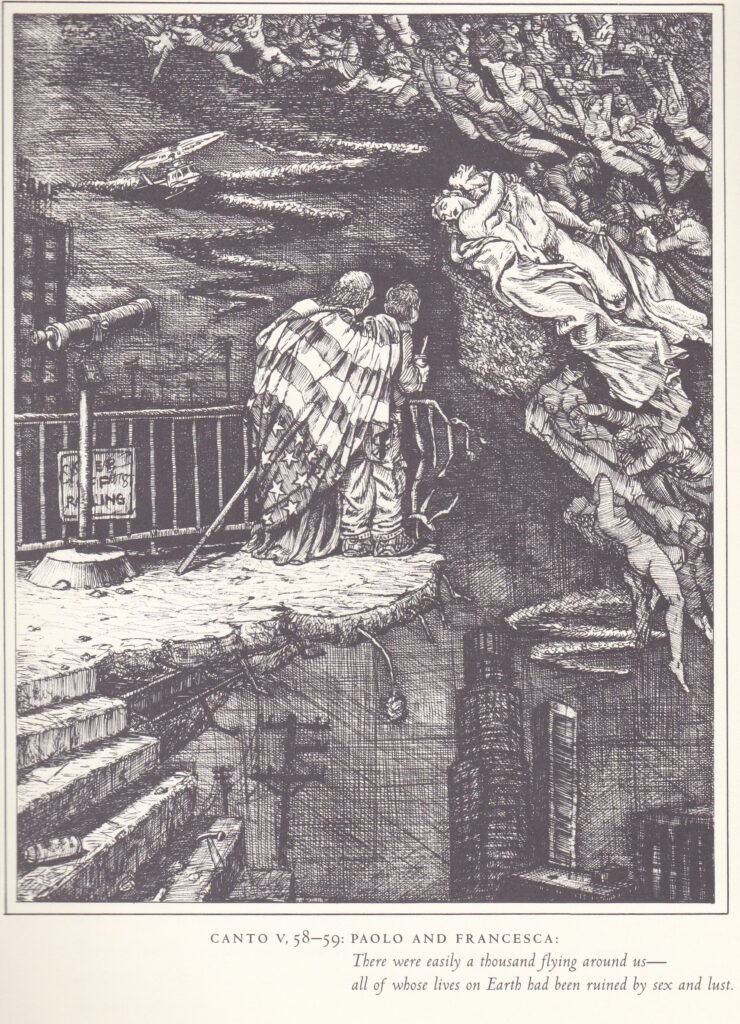
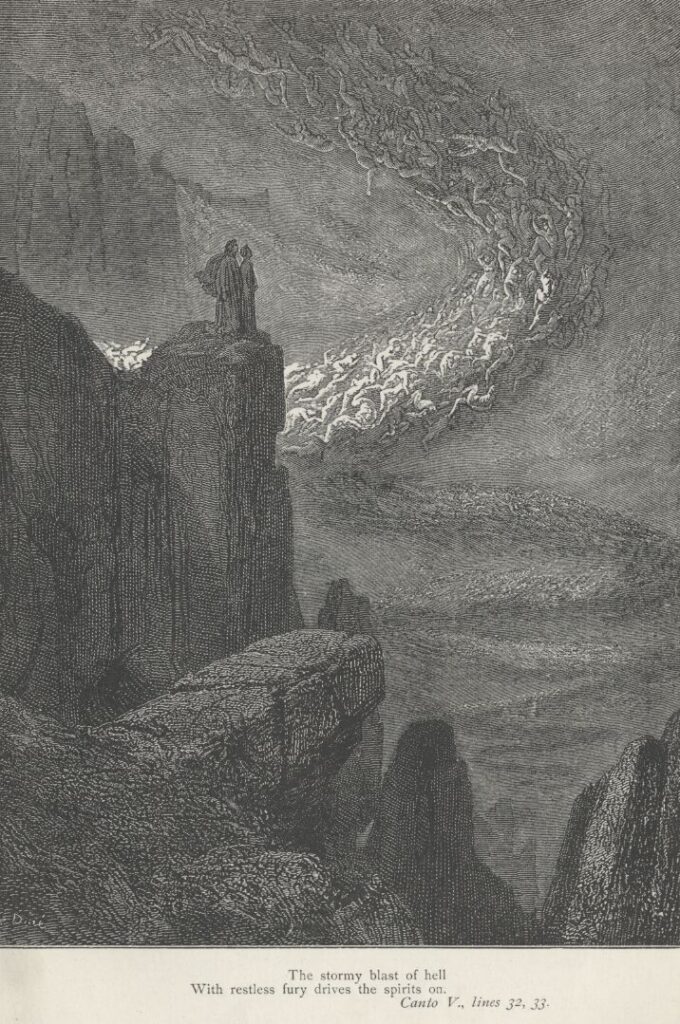
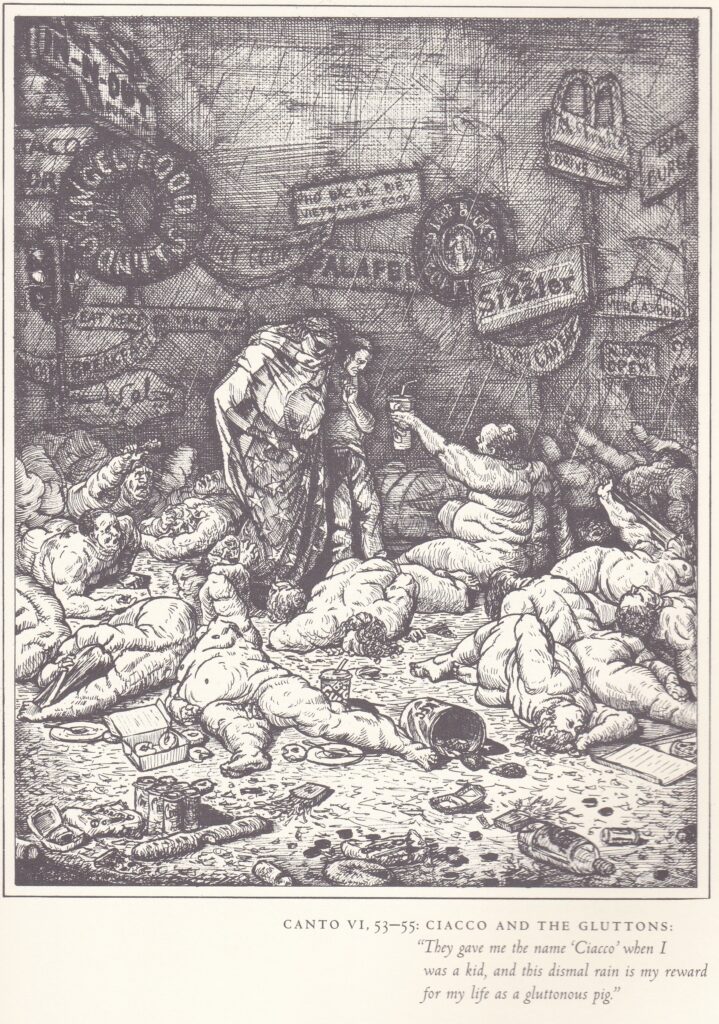

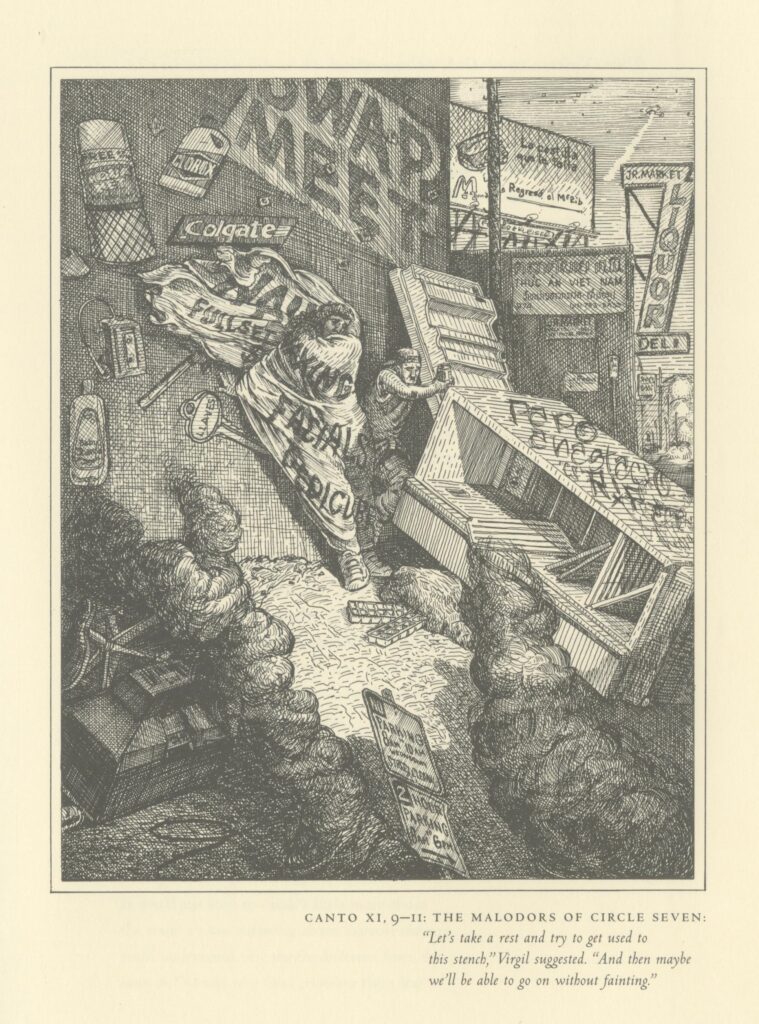
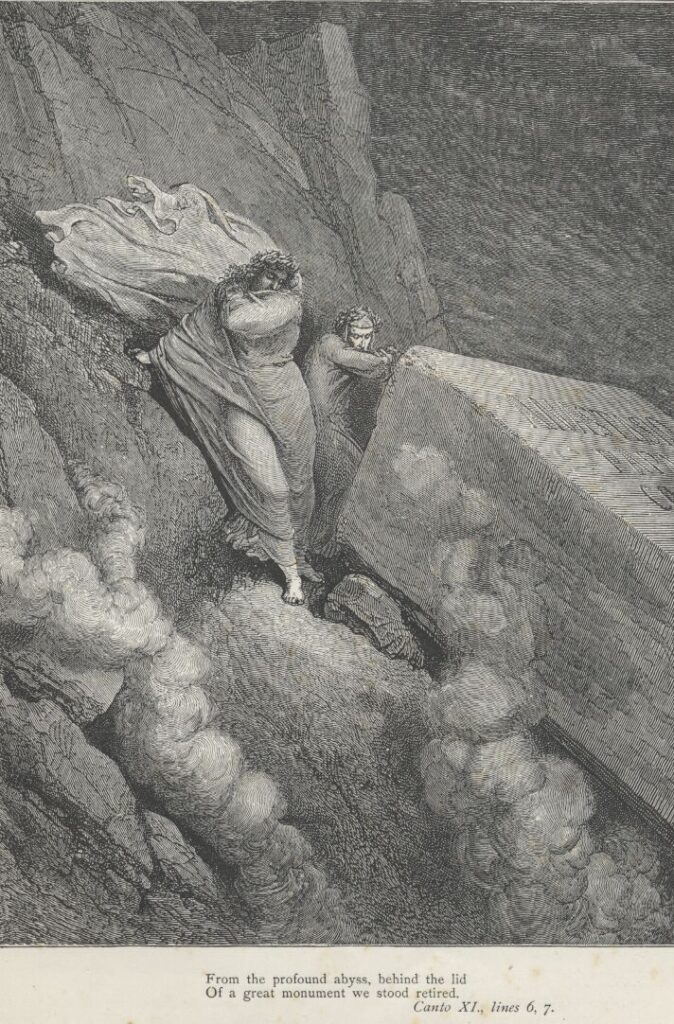


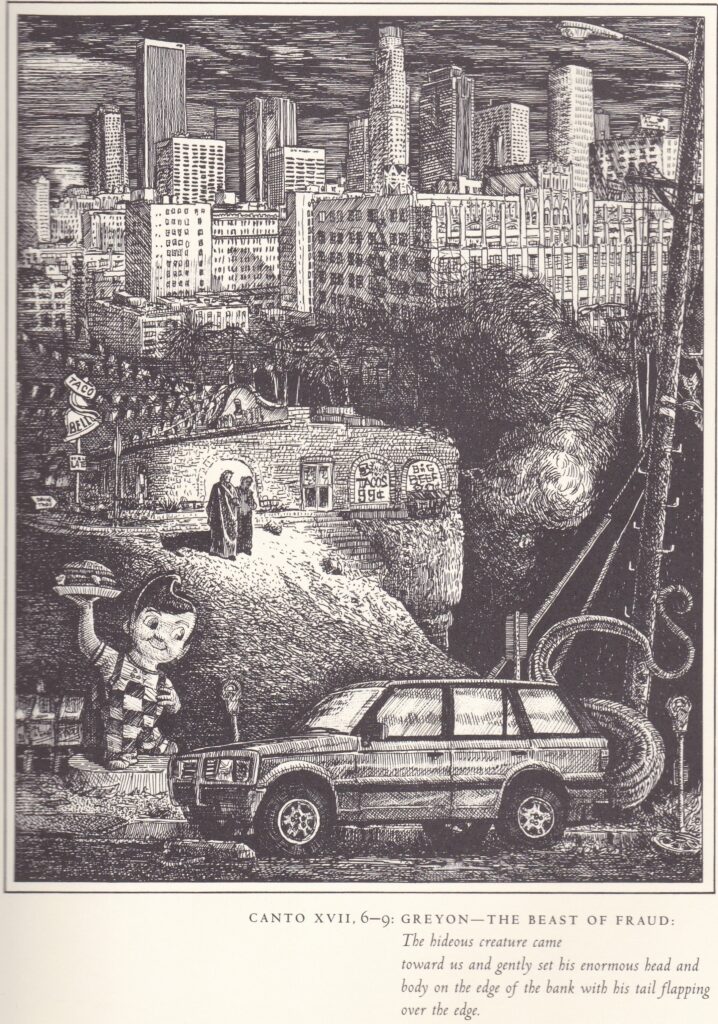


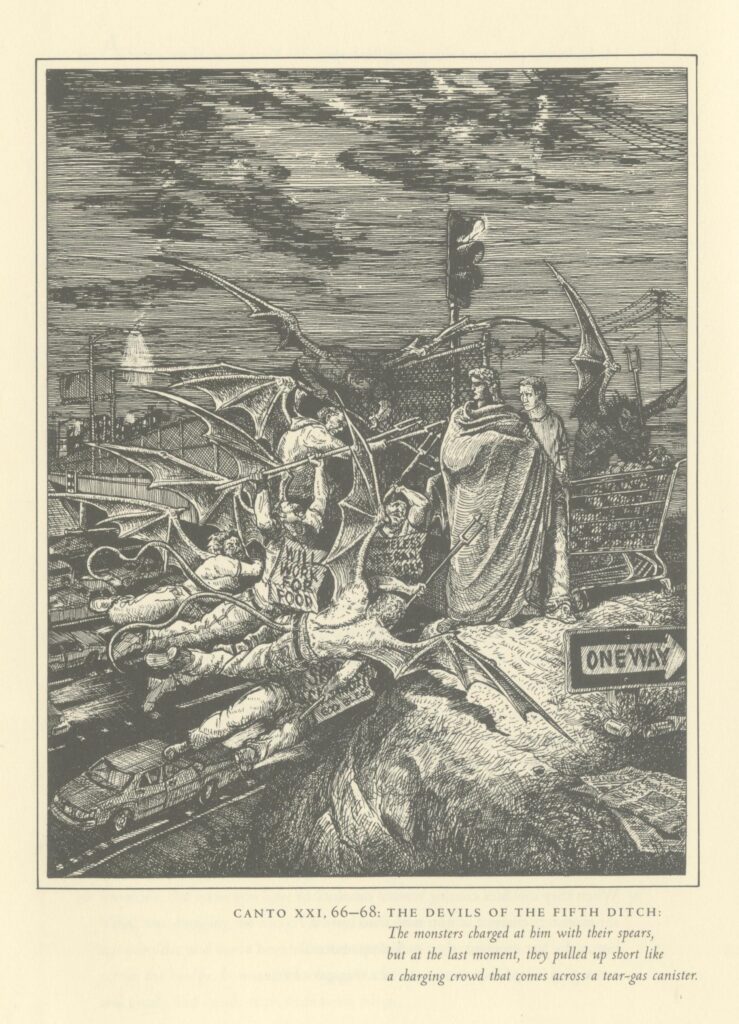
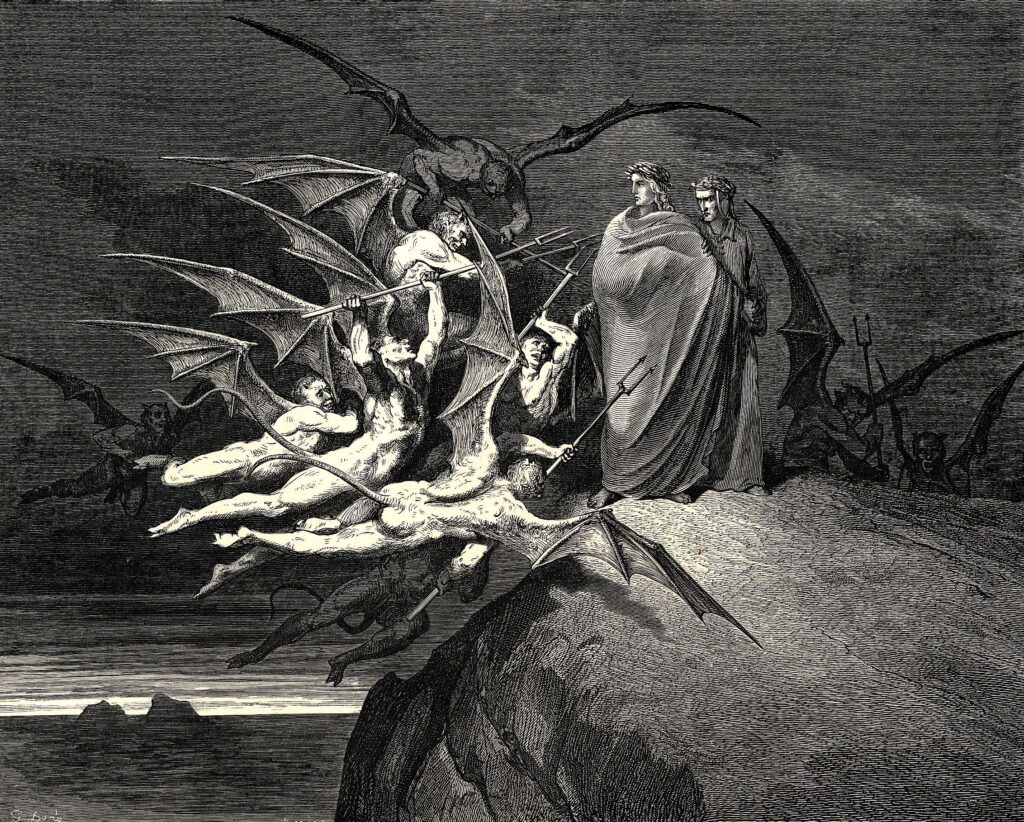
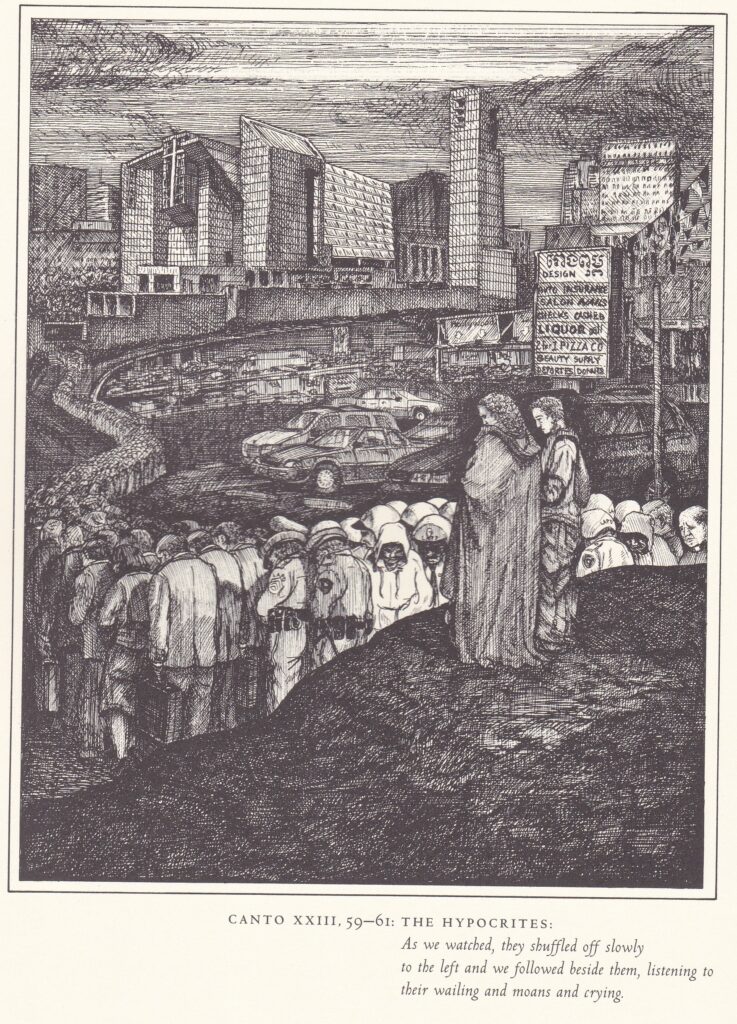
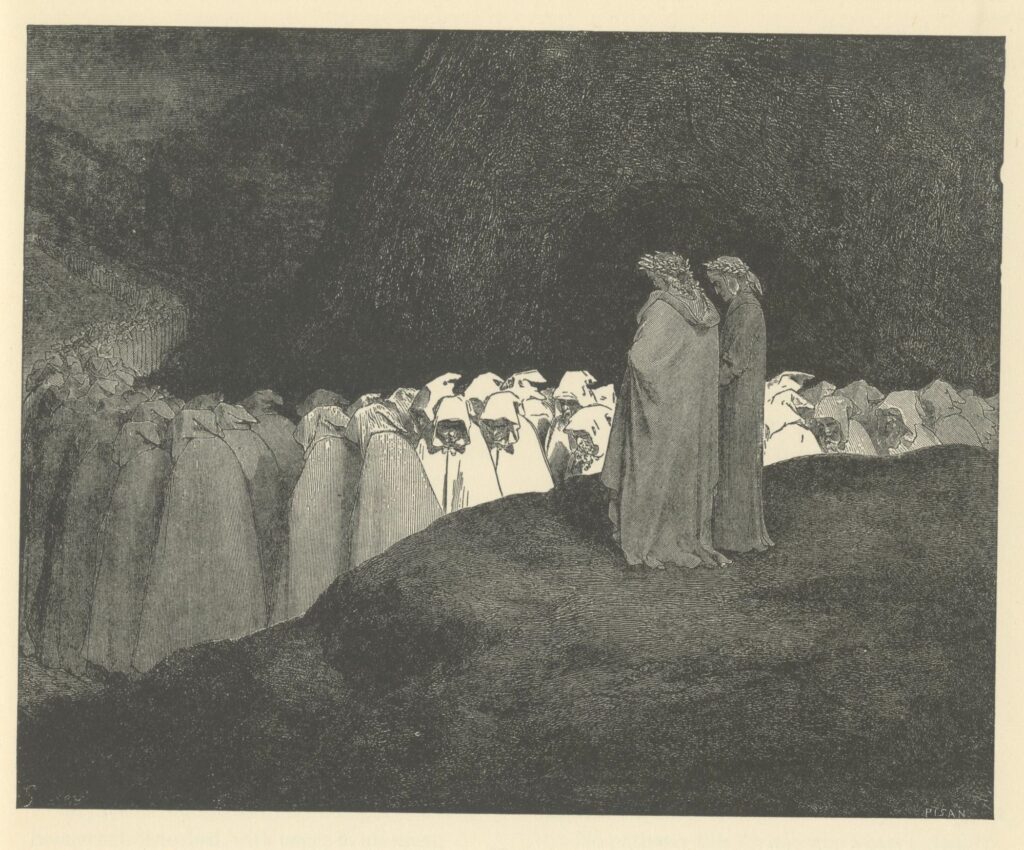
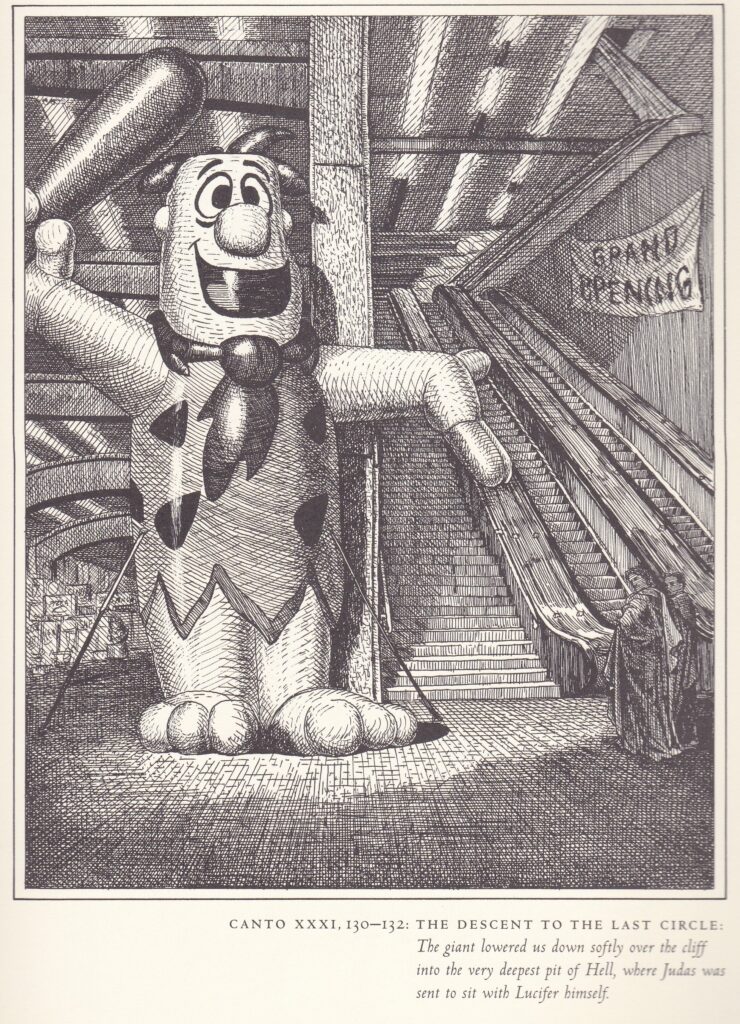
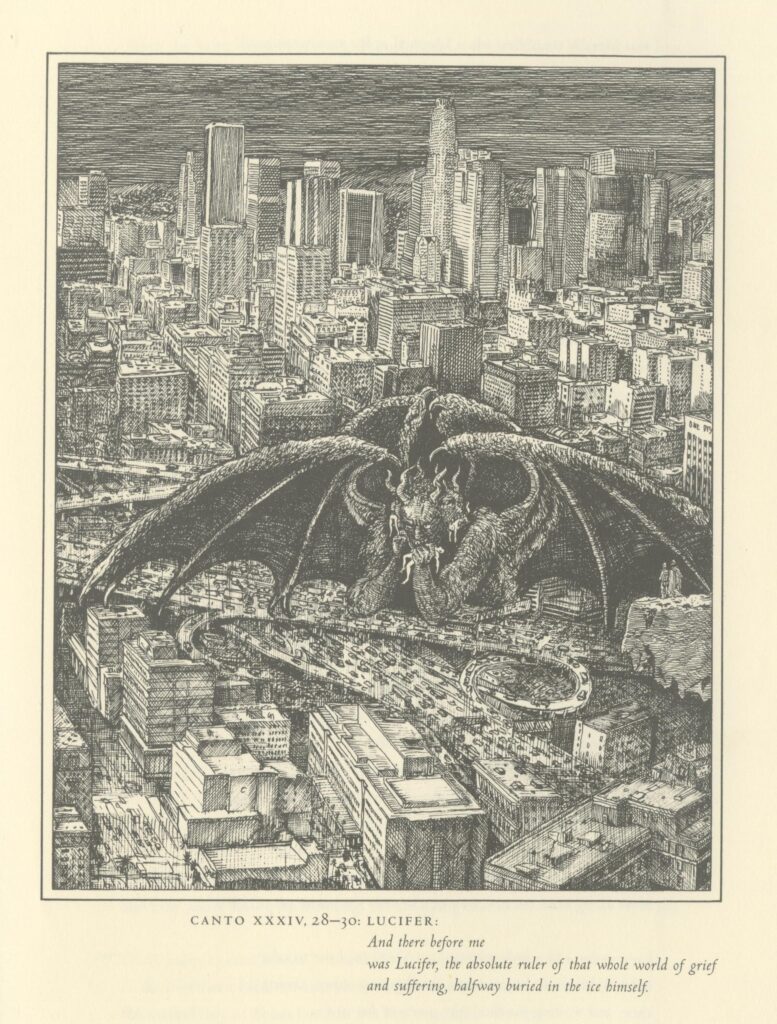
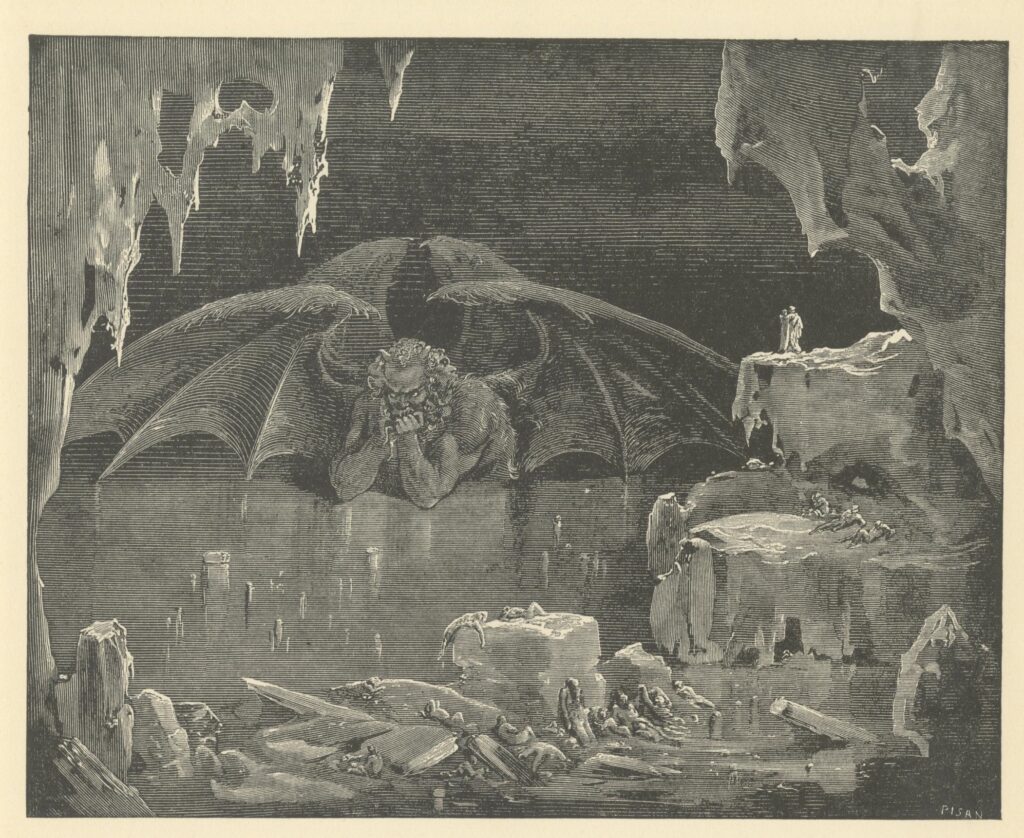
 Return to top
Return to top